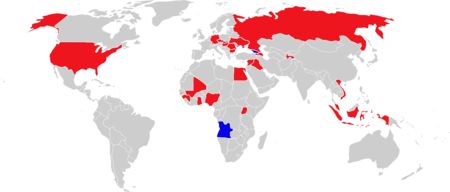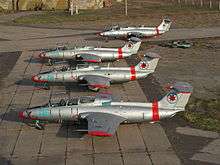Aero L-29 Delfín
| L-29 Delfín | |
|---|---|
.jpg) | |
| Aero L-29 Delfín | |
| Role | Military trainer aircraft Light attack |
| Manufacturer | Aero Vodochody |
| Designer | Ing. Jan Vlček, Z. Rublič and K. Tomáš |
| First flight | 5 April 1959 |
| Introduction | 1961 |
| Status | Limited service; popular civilian warbird |
| Primary users | Soviet Air Force Czechoslovak Air Force Bulgarian Air Force |
| Produced | 1963-1974 |
| Number built | 3,500 |
The Aero L-29 Delfín (English: Dolphin, NATO reporting name: Maya) is a military jet trainer aircraft that became the standard jet trainer for the air forces of Warsaw Pact nations in the 1960s. It was Czechoslovakia's first locally designed and built jet aircraft.
Design and development
In the late 1950s, the Soviet Air Force was seeking a jet-powered replacement for its fleet of piston-engined trainers, and this requirement was soon broadened to finding a trainer aircraft that could be adopted in common by Eastern Bloc air forces. Aero's response, the prototype XL-29 designed by Z. Rublič and K. Tomáš first flew on 5 April 1959, powered by a British Bristol Siddeley Viper engine. The second prototype was powered by the Czech-designed M701 engine, which was used in all subsequent aircraft.
The basic design concept was to produce a straightforward, easy-to-build and operate aircraft. Simplicity and ruggedness were stressed with manual flight controls, large flaps and the incorporation of perforated airbrakes on the fuselage sides providing stable and docile flight characteristics, leading to an enviable safety record for the type. The sturdy L-29 was able to operate from grass, sand or unprepared fields. Both student pilot and instructor had ejection seats, and were positioned in tandem, under separate canopies with a slightly raised instructor position.
In 1961, the L-29 was evaluated against the PZL TS-11 Iskra and Yakovlev Yak-30 and emerged the winner. Poland chose to pursue the development of the TS-11 Iskra anyway, but all other Warsaw Pact countries adopted the Delfin under the agreements of COMECON.

Production began April 1963 and continued for 11 years, with 3,600 eventually built until 1974. A dedicated, single-seat, aerobatic version was developed as the L-29A Akrobat. An armed reconnaissance version with cameras mounted in the rear cockpit, looking downwards and (optional) either a gun pod or a pod for four unguided missiles under each wing was built as the L-29R.
Operational history
More than 2,000 L-29s were supplied to the Soviet Air Force, acquiring the NATO reporting name "Maya." As a trainer, the L-29 enabled air forces to adopt an "all-through" training on jet aircraft, replacing earlier piston-engined types.
The Delfin served in basic, intermediate and weapons training roles. For this latter mission, they were equipped with hardpoints to carry gunpods, bombs or rockets, and thus armed, Egyptian L-29s were sent into combat against Israeli tanks during the Yom Kippur War. On July 16, 1975, a Czechoslovak Air Force L-29 shot down a Polish civilian biplane piloted by Dionizy Bielański that was attempting to defect to the West.[1]
The L-29 was supplanted in the inventory of many of its operators by the Aero L-39 Albatros. L-29s, along with the newer L-39, were used extensively in ground attack missions in the Nagorno-Karabakh War by Azeri forces. At least 14 were shot down by Armenian air-defences, out of the total inventory of 18 L-29s. The Azeri Air Force lost large amounts of its air force due to anti aircraft fire.[2]
On October 2, 2007, an unmodified L-29 was used for the world’s first jet flight powered solely by 100% biodiesel fuel. Pilots Carol Sugars and Douglas Rodante flew their Delphin Jet from Stead Airport, Reno, Nevada to Leesburg International Airport, Leesburg, Florida in order to promote environmentally friendly fuels in aviation.[3]
From September 10 to September 14, 2008, two L-29s took first and second place at the Reno Air Races. Both L-29s consistently posted laps at or above 500 miles per hour. Former Astronaut Curt Brown took first place in "Viper," followed by Red Bull racer Mike Mangold in "Euroburner."
Russia says it destroyed two Georgian L-29s during the 2008 South Ossetia war.[4] War in Donbass separatists claimed to have an operational L-29 on 18 January 2015.[5]
Operators

Current Military Operators

-
 Angola
Angola - National Air Force of Angola - 6 L-29s were in service as of December 2016.[6]
-
 Georgia
Georgia - Army Air Section - 4 L-29s were in service as of December 2016.[6]
Former Military Operators

-
 Afghanistan
Afghanistan - The Afghan Air Force operated as many as 24 from 1978 to as late as 1999.
-
 Armenia
Armenia - The Armenian Air Force
-
 Azerbaijan
Azerbaijan - The Azerbaijani Air and Air Defence Force
-
 Bulgaria
Bulgaria - Bulgarian Air Force operated 102 examples, delivered between 1963–1974, retired from service in 2002.
-
 Czech Republic
Czech Republic - Czech Air Force[7]
-
 Czechoslovakia
Czechoslovakia - The Czechoslovak Air Force
-
 East Germany
East Germany - East German Air Force
-
 Egypt
Egypt - Egyptian Air Force[8] - withdrawn
-
 Ghana
Ghana - Ghana Air Force[9]
-
 Guinea
Guinea - Military of Guinea[10]
-
 Hungary
Hungary - Hungarian Air Force - withdrawn
-
 Indonesia
Indonesia - Indonesian Air Force
-
 Iraq
Iraq - Iraqi Air Force - Received 78 L-29s between 1968 and 1974. A number were converted to Unmanned aerial vehicles in the 1990s.[11] No longer operated
-
 Libya
Libya - Libyan Arab Republic Air Force 20 L29s recorded lost in 1987 during the final stages of the Chadian–Libyan conflict[12]
-
 Mali
Mali - Air Force of Mali - 6 in service as of December 2012.[13]
-
 Nigeria
Nigeria - Nigerian Air Force
-
 Romania
Romania - Romanian Air Force[14] - all the L-29 have been retired in 2006
-
 Slovakia
Slovakia - Slovak Air Force - after dissolution of Czechoslovakia, 16 L-29 were given to newly independent Slovak Air Force.[15] They were withdrawn in 2003.
-
 Syria
Syria - Syrian Air Force[16]
-
 Uganda
Uganda - Ugandan Air Force
-
 Ukraine
Ukraine - Ukrainian Air Force[17]
-
 Vietnam
Vietnam - Vietnam People's Air Force
 United States
United States- United States Navy[18]
-
 Soviet Union
Soviet Union - operated as many as 2,000
Civil operators
- One private L-29, with experimental registration LV-X468; during 20111 & 2012 was registered in Uruguay as CX-LVN.
- One private L-29C,VH-BQJ. Based near Sydney, New South Wales.
- Private L-29C, OK-ATS, Czech Jet Team Žatec - Macerka. [19] Plane crashed on 10 June 2012, killing pilot and passenger.
- Private L-29, OK-AJW, Blue Sky Service Brno - Tuřany [20]
- Private L-29, C-FLVB, operated by International Test Pilot School, Canada as a Flight Test Training tool.
- Two private L-29s, operated by the ACER Cold War Museum. Ex-Bulgarian Air Force. [21]
- One L-29C, OY-LSD owned by Lasse Rungholm, Niels Egelund (until 31.12.2015), Claus Brøgger and Kåre Selvejer.[22]
- L-29 ZK-JET operated on commercial joyflights by Double X Aviation, Queenstown Airport
- L-29 ZK-SSU and ZK-VAU operated by Soviet Star from Christchurch International Airport. [23]
- Two L-29C, LN-ADA and LN-KJJ, operated by Russian Warbirds of Norway. One of the jets (LN-KJJ) has been modified to an L-29 Viper with a RR Viper MK-535 [24]
- One civilian L-29 and one L-29 Viper operated by Feniks Aeroclub outside Moscow[25]
- Several L-29s operated by DOSAAF
- One private L-29C, OM-JET, owned by Ján Slota[26]
- One L-29, OM-JLP is owned by Slovtepmont Inc. [27]
- Cpt. Jozef Vaško and col. Radomil Peca in retirement are owners of one L-29, OM-SLK [28]
- Two Sasol Tigers aerobatic team flying the L-29
- University of Iowa Operator Performance Laboratory. Used as high dynamics flight research aircraft for development of pilot state characterization [29]
- One L-29, N29CZ, is operated by World Heritage Air Museum, in Detroit, Michigan. [30]
- One as an avionics high dynamics flight test aircraft at the Ohio University Avionics Engineering Center [31]
- One L-29C, N61300, is operated by DK Aviation Services, in Dallas Texas
Specifications (L-29)


Data from Jane's All The World's Aircraft 1971–72[32]
General characteristics
- Crew: 2: student and instructor
- Length: 10.81 m (35 ft 5½ in)
- Wingspan: 10.29 m (33 ft 9 in)
- Height: 3.13 m (10 ft 3 in)
- Wing area: 19.8 m² (213 ft²)
- Empty weight: 2,280 kg (5,027 lb)
- Loaded weight: 3,280 kg (7,231 lb)
- Max. takeoff weight: 3,540 kg (7,804 lb)
- Powerplant: 1 × Motorlet M-701C 500 turbojet, 8.7 kN (1,960 lbf)
Performance
- Never exceed speed: 820 km/h (442 knots, 510 mph)
- Maximum speed: 655 km/h (353 knots, 407 mph) at 5,000 m (16,400 ft)
- Stall speed: 130 km/h (71 knots, 81 mph) flaps down
- Range: 894 km (480 nmi, 555 mi) with tip tanks
- Endurance: 2 hours 30 min
- Service ceiling: 11,000 m (36,100 ft)
- Rate of climb: 14.0 m/s (2,755 ft/min)
Armament
- 200 kg (440 lb) of various guns, bombs, rockets, and missiles on external hardpoints
See also
- Related development
- Aircraft of comparable role, configuration and era
References
- Notes
- ↑ http://www.radio.cz/en/article/115295
- ↑ http://www.acig.org/artman/publish/article_280.shtml
- ↑ http://www.scientificamerican.com/article.cfm?id=biodiesel-takes-to-the-sky
- ↑ http://www.globalsecurity.org/military/world/georgia/af.htm
- ↑ https://www.youtube.com/watch?v=W91S3-_tnRU
- 1 2 "World Air Forces 2017". Flightglobal Insight. 2016. Retrieved 9 February 2017.
- ↑ Flight International 16–22 November 2004, pp. 53–54.
- ↑ Flight International 16–22 November 2004, p. 56.
- ↑ Flight International 16–22 November 2004, p. 59.
- ↑ Flight International 16–22 November 2004, p. 62.
- ↑ Vala Aviation News May 2003, pp. 355–357
- ↑ K. Pollack, Arabs at War, Chapter 4
- ↑ Hoyle Flight International 11–17 December 2012, p. 55.
- ↑ Flight International 16–22 November 2004, pp. 81–82.
- ↑ "Archived copy". Archived from the original on 2012-10-15. Retrieved 2012-06-03.
- ↑ Flight International 16–22 November 2004, p. 88.
- ↑ Flight International 16–22 November 2004, pp. 91–92.
- ↑ http://www.strategypage.com/htmw/htnavai/articles/20100629.aspx
- ↑ "Archived copy". Archived from the original on 2009-06-03. Retrieved 2008-11-18.
- ↑
- ↑ "Our Aircraft." ACM Warbirds of Canada.
- ↑
- ↑ "Archived copy". Archived from the original on 2015-01-13. Retrieved 2015-01-22.
- ↑ "Russian Warbirds Norway." Retrieved: 19 June 2017.
- ↑ http://maximov.aero/planes/
- ↑
- ↑
- ↑
- ↑ "Operator Performance Laboratory." College of Engineering, University of Iowa. Retrieved: 19 June 2017.
- ↑ "Aero Vodochody L29." World Heritage Air Museum. Retrieved: 19 June 2017.
- ↑ "Delfin L-29." Russ College of Engineering and Technology, Ohio University. Retrieved: 19 June 2017.
- ↑ Taylor 1971,p.29.
- Bibliography
- Gunston, Bill, ed. "Aero L-29 Delfin." The Encyclopedia of World Air Power. New York: Crescent Books, 1990. ISBN 0-517-53754-0.
- Hoyle, Craig. "World Air Forces Directory". Flight International. Vol. 180, No. 5321. 13–19 December 2011. pp. 26–52. ISSN 0015-3710.
- Hoyle, Craig. "World Air Forces Directory". Flight International. Vol. 182, No. 5370. 11–17 December 2012. pp. 40–64. ISSN 0015-3710.
- Hoyle, Craig. "World Air Forces Directory". Flight International. Vol. 188, No. 5517. 8–14 December 2015. pp. 26–53. ISSN 0015-3710.
- Taylor, John W. R. Jane's All The World's Aircraft 1971–72. London:Jane's Yearbooks,1971. ISBN 0-354-00094-2.
- Vala, Vojtec. "Saddam's Deadly Drones". Aviation News. Vol 65, No, 5. May 2003. pp. 355–357.
- "World Air Forces 2004" Flight International. Vol. 166, No. 4960. 16–22 November 2004. pp. 41–100. ISSN 0015-3710.
External links
| Wikimedia Commons has media related to Aero L-29. |
- (1961) Aero L-29 Delfin Flight Manual
- Czech Jet Team — civilian display team.
- Aircraft.co.za - The Complete Aviation Reference
- Warbird Alley L-29 Page
- Gauntlet Warbirds — L-29 Training in the Chicago Area
- Walkaround L-29 Delfin from Poltava
- Walkaround L-29 Delfin from Yegoryevsk
- Walkaround L-29 Delfin from Zaporozhye
- Soviet Star, Christchurch, New Zealand
- Double X Aviation Ltd, Queenstown, New Zealand
